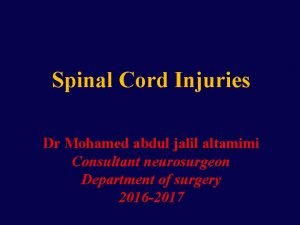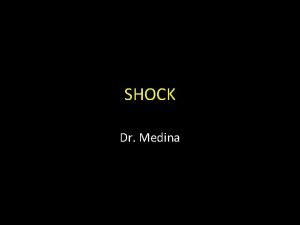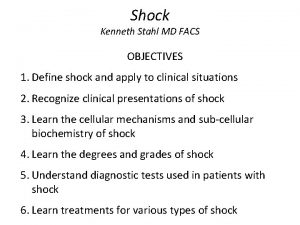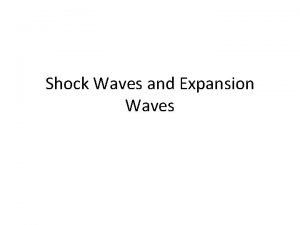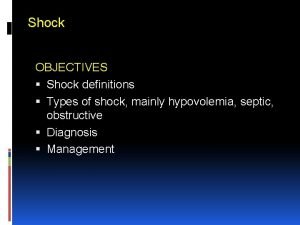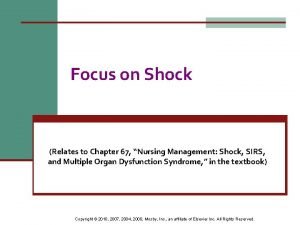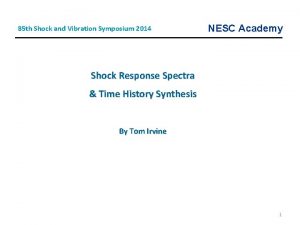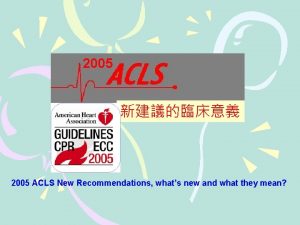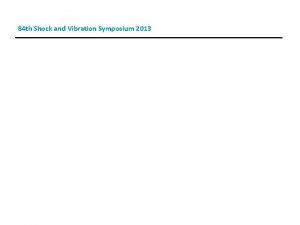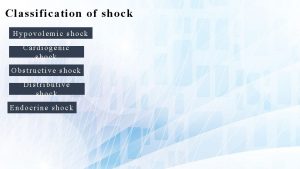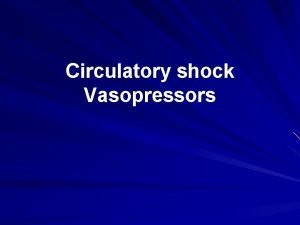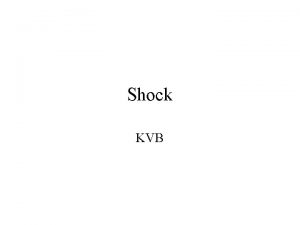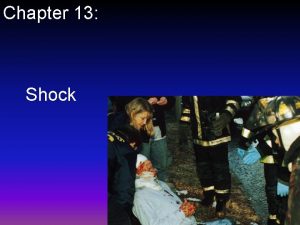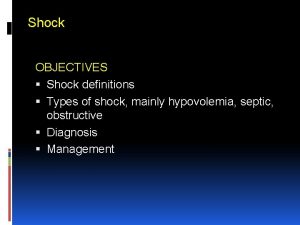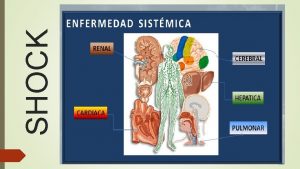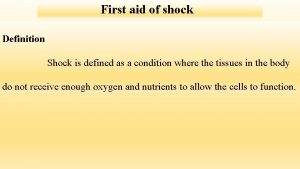Definition and Classification of Shock Definition of Shock




















- Slides: 20

Definition and Classification of Shock ד"ר אסתר דהאן

Definition of Shock is an acute clinical syndrome initiated by ineffective perfusion, resulting in severe dysfunction of organs vital to survival. Shock is not a synonym to hypotension!

Ineffective perfusion Organ perfusion compromised by an overall decrease or maldistribution in cardiac output Worsened by abnormalities of distribution of blood flow within the organs.

Shock syndromes Relatively constant set of signs and symptoms that predictably result from pathophysiologic events Clinical presentation can be variable Ø Ø Ø Severity of the perfusion defect Underlying cause Prior organ dysfunction

Symptoms/Signs l Related l Pale, to decreased tissue perfusion cool, clammy skin l capillary refill l urine output l mental status

Classification l Hypovolemic l Cardiogenic l Extracardiac l Distributive obstructive

Hypovolemic Primary defect is a decrease in intravascular volume l Bleeding l GI losses l Urinary l “Third spacing”

Mechanisms l in cardiac diastolic filling pressures l stroke volume l CO partially maintained by HR l PVR, myocardial contractility l Brain, heart protected through auto regulation Failure of compensation 2025%

Clinical manifestations Ø Tachycardia Ø Tachypnea Ø Flat veins Ø Signs of hypo perfusion

Effects of CO Ø Decreased oxygen delivery Ø Tissues initially compensate through increased oxygen extraction Ø Eventual tissue hypoxia and lactic acidosis Ø Diversion of flow to brain, heart Ø Eventually fails worsening CO

Cardiogenic Shock Ø Primary defect is CO with elevated cardiac chamber filling pressures Ø Pulmonary Ø oedema JVP Ø Presentation otherwise similar to hypovolemia Ø Can be confused by underlying hypovolemia Ø CI <2 L/min/m 2 Ø PAOP >17 -20 mm. Hg

Causes of CO l Contractile failure Ischemia/infarction Cardiomyopathy myocarditis l Arrhythmias l Conduction disturbances l Valve lesions l AMI complications

Left ventricular MI l >40% of LV infracted l 10 -20% of Q-wave AMI l Mortality >75% unless surgically correctable lesion l Mortality associated with level of acidosis

Right Ventricular AMI l RV involved in 50% of inferior infarcts l l Clear 10 -20% results in cardiogenic shock lungs JVP l Kussmaul’s sign l l Prominent venous distention with inspiration

Extracardiac Obstructive Shock l Impaired diastolic filling Cardiac tamponade l Tension pneumothorax l Constrictive pericarditis l Compression of great vessels by mediastinal masses l l Increase the R or L ventricular after load PE l Acute pulmonary hypertension l Aortic dissection l Systemic embolization l

Varied Clinical Presentation l Signs of decreased perfusion l Symptoms/signs related to cause l Neck veins may be present or absent l Muffled heart sounds l Pulses paradoxus l Symptoms of underlying cause l Varied hemodynamic patterns

Distributive Shock l SIRS l Sepsis l Pancreatitis l Multitrauma l Burns l Late hemorrhage l Neurogenic l Anaphylaxis l Adrenal

Hemodynamic pattern l Hyperdynamic pattern l Primary defect is a in SVR secondary to NO production l in CO l Normal to low filling pressures l Normal to mixed venous O 2 tension l ? AV shunt

Sepsis/SIRS l Two or more of the following l Temp > 38 C, < 36 C l Tachycardia l Tachypnea or respiratory alkalosis l WBC >12, <4, or >10% bands l Severe sepsis l Hypotension or hypo perfusion l Shock l Vasopressors or ionotropes

 Spinal shock vs neurogenic shock
Spinal shock vs neurogenic shock Shock normovolemico
Shock normovolemico Spinal shock vs neurogenic shock
Spinal shock vs neurogenic shock Spinal shock symptoms
Spinal shock symptoms Subacute combined degeneration of the cord
Subacute combined degeneration of the cord Hemorrhagic shock classification
Hemorrhagic shock classification Quantitative classification in statistics
Quantitative classification in statistics Shock tactics examples
Shock tactics examples Reality shock definition
Reality shock definition Oblique shock wave
Oblique shock wave Patholgy
Patholgy Definition of shock
Definition of shock Distributive shock
Distributive shock Shock definition
Shock definition Pathophysiology of hypovolemic shock
Pathophysiology of hypovolemic shock Insulin shock medical definition
Insulin shock medical definition Signs and symptoms of shock
Signs and symptoms of shock Chapter 14 bleeding shock and soft tissue injuries
Chapter 14 bleeding shock and soft tissue injuries Nesc academy
Nesc academy Defibrillation waveform
Defibrillation waveform Shock and vibration symposium
Shock and vibration symposium
